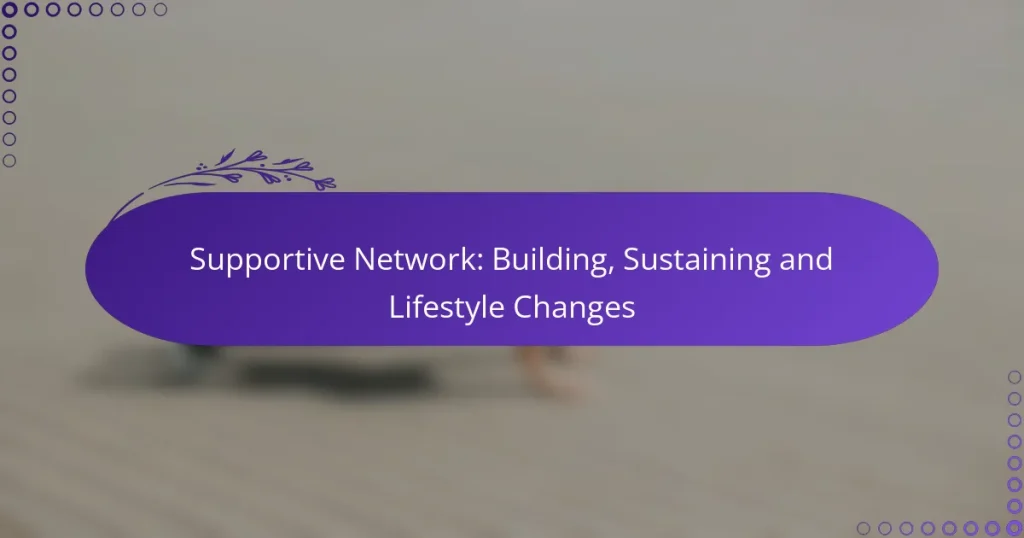Building a supportive network is essential for personal and professional growth, particularly in urban communities where connections can lead to a greater sense of belonging. Sustaining this network requires consistent communication and mutual support, ensuring that all members remain engaged and accountable. Additionally, embracing lifestyle changes can further strengthen these networks by fostering healthier relationships and shared goals among like-minded individuals.
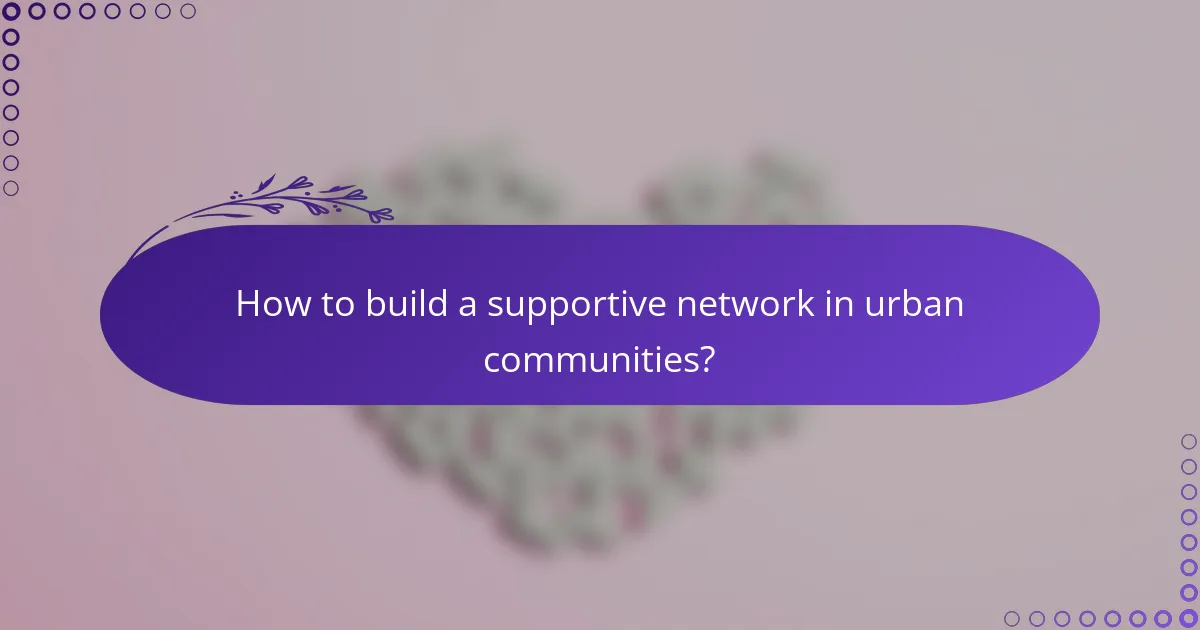
How to build a supportive network in urban communities?
Building a supportive network in urban communities involves connecting with local individuals and groups who share similar interests and goals. This can enhance personal and professional growth while fostering a sense of belonging.
Engage in local meetups
Local meetups are gatherings organized around specific interests, hobbies, or professional fields. Participating in these events allows you to meet like-minded individuals and expand your social circle.
Look for meetups on platforms like Meetup.com or local community boards. Consider attending events that align with your interests, such as book clubs, fitness groups, or tech talks, to ensure you connect with people who share your passions.
Join community organizations
Community organizations often focus on various causes, from environmental issues to social justice. By joining these groups, you can contribute to meaningful initiatives while meeting others who are committed to similar causes.
Research local organizations through city websites or community centers. Many groups offer membership options that include regular meetings, volunteer opportunities, and networking events, which can help you build lasting relationships.
Utilize social media groups
Social media platforms host numerous groups dedicated to specific interests or local communities. These online spaces can be excellent for connecting with individuals in your area and sharing resources or advice.
Search for Facebook groups or LinkedIn communities that focus on your interests or local events. Engage actively by participating in discussions and sharing your experiences, which can lead to offline connections.
Attend workshops and seminars
Workshops and seminars provide opportunities for learning and networking. These events often feature experts sharing knowledge on various topics, allowing you to gain insights while meeting others interested in the same subjects.
Check local universities, community colleges, or professional organizations for upcoming workshops. Participating in these events can enhance your skills and introduce you to potential collaborators or mentors.
Participate in volunteer activities
Volunteering is a powerful way to connect with others while giving back to the community. Engaging in volunteer work can help you meet people who share your values and commitment to making a difference.
Look for local charities or non-profits that align with your interests. Regularly volunteering can lead to forming strong bonds with fellow volunteers, creating a supportive network that extends beyond the activity itself.
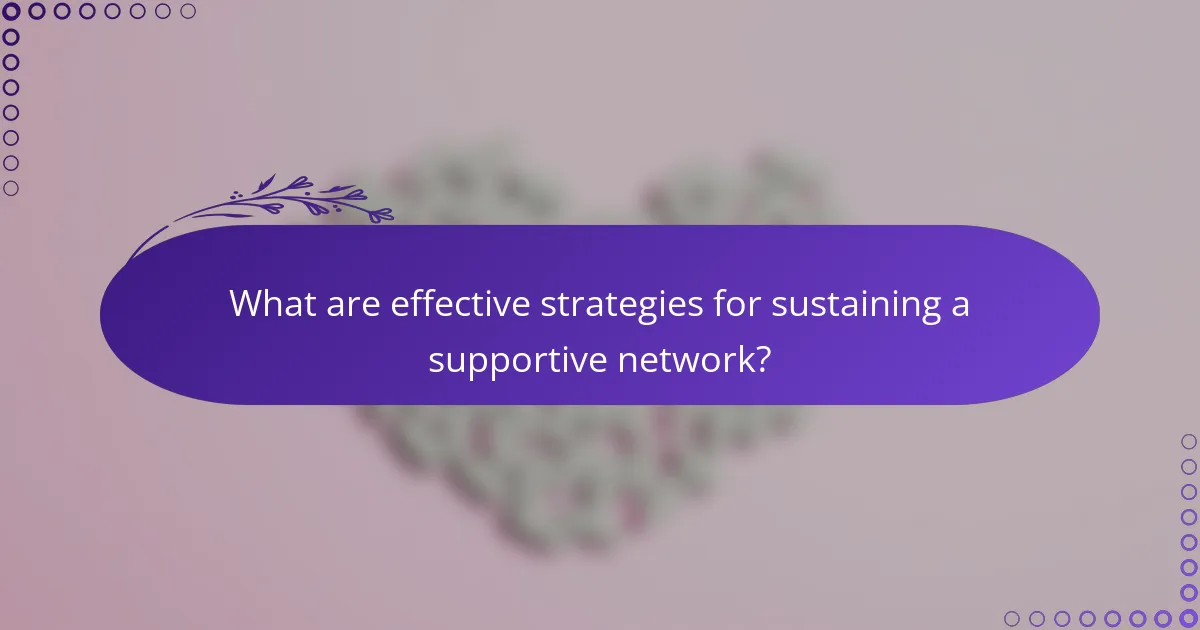
What are effective strategies for sustaining a supportive network?
To sustain a supportive network, focus on consistent communication, engaging group activities, mutual support, and establishing accountability among members. These strategies foster deeper connections and ensure that everyone remains committed to the group’s goals.
Regular communication
Maintaining regular communication is essential for a supportive network. Schedule weekly or bi-weekly check-ins through phone calls, video chats, or messaging apps to share updates and offer encouragement.
Consider setting up a group chat or forum where members can share experiences and resources. This keeps everyone informed and engaged, creating a sense of belonging.
Organize group activities
Group activities strengthen bonds and make interactions more enjoyable. Plan monthly meetups, whether in-person or virtual, focusing on shared interests like fitness, hobbies, or learning new skills.
Activities can range from casual coffee meetups to structured workshops. Aim for a mix of social and goal-oriented events to cater to different preferences and encourage participation.
Provide mutual support
Encouraging mutual support is vital for a thriving network. Members should feel comfortable sharing challenges and celebrating successes. Create an environment where everyone can offer and receive help without judgment.
Consider implementing a system where members can request support on specific issues, whether emotional or practical. This could be as simple as a monthly roundtable discussion or a shared document where needs are posted.
Establish accountability partners
Accountability partners can enhance commitment within the network. Pair members based on their goals, allowing them to check in on each other’s progress regularly and provide motivation.
Set clear expectations for these partnerships, such as weekly goal reviews or daily text check-ins. This structure helps maintain focus and encourages members to stay on track with their personal and collective objectives.
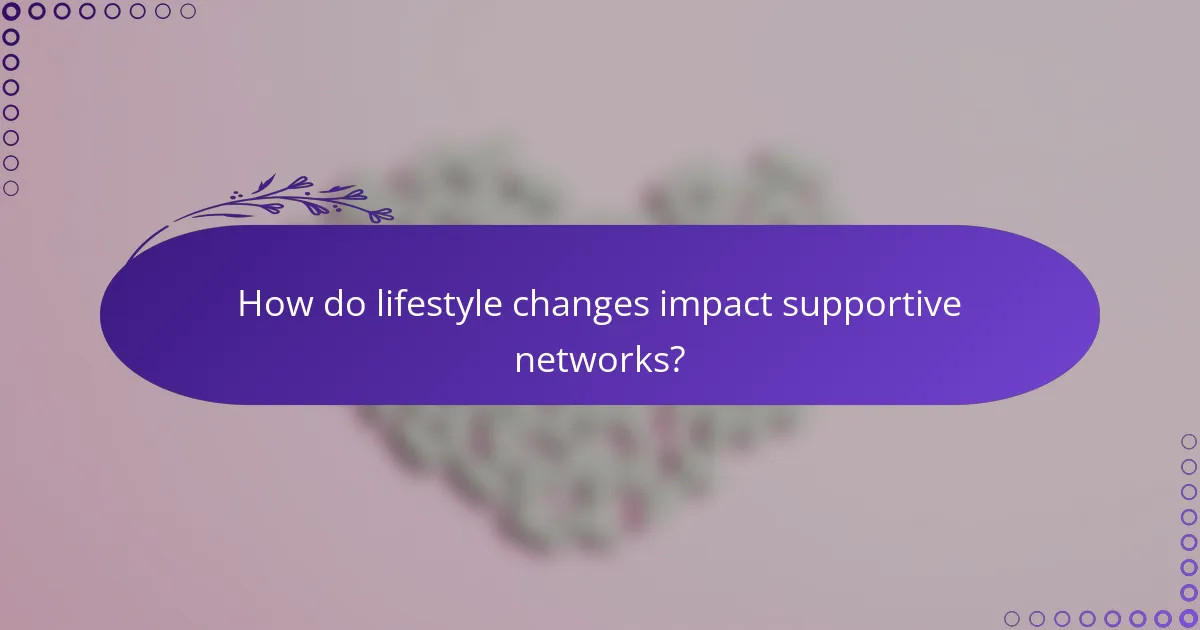
How do lifestyle changes impact supportive networks?
Lifestyle changes can significantly strengthen supportive networks by fostering healthier relationships and shared objectives. When individuals adopt new habits, they often seek out like-minded peers, which can enhance motivation and accountability.
Promote healthy habits
Supportive networks can encourage members to adopt healthy habits by sharing resources and experiences. For example, a group might organize regular exercise sessions or healthy cooking classes, making it easier for individuals to participate and stay committed.
Additionally, members can share tips on nutrition, mental well-being, and stress management, creating a culture of health. This collective approach not only reinforces individual efforts but also builds a sense of community around wellness.
Encourage shared goals
Setting shared goals within a supportive network can enhance motivation and commitment. When individuals work towards common objectives, such as weight loss or fitness milestones, they can celebrate achievements together, fostering a sense of belonging.
To implement this, groups can establish specific, measurable goals and track progress collectively. Regular check-ins can help maintain focus and accountability, ensuring that everyone stays engaged in their journey.
Facilitate skill development
Supportive networks can play a crucial role in skill development by providing opportunities for learning and practice. Members can share their expertise, whether in cooking, fitness techniques, or stress reduction strategies, helping others to acquire new skills.
Workshops, group activities, or online resources can be utilized to facilitate this learning. By creating an environment where individuals feel comfortable asking questions and sharing knowledge, networks can enhance personal growth and resilience.
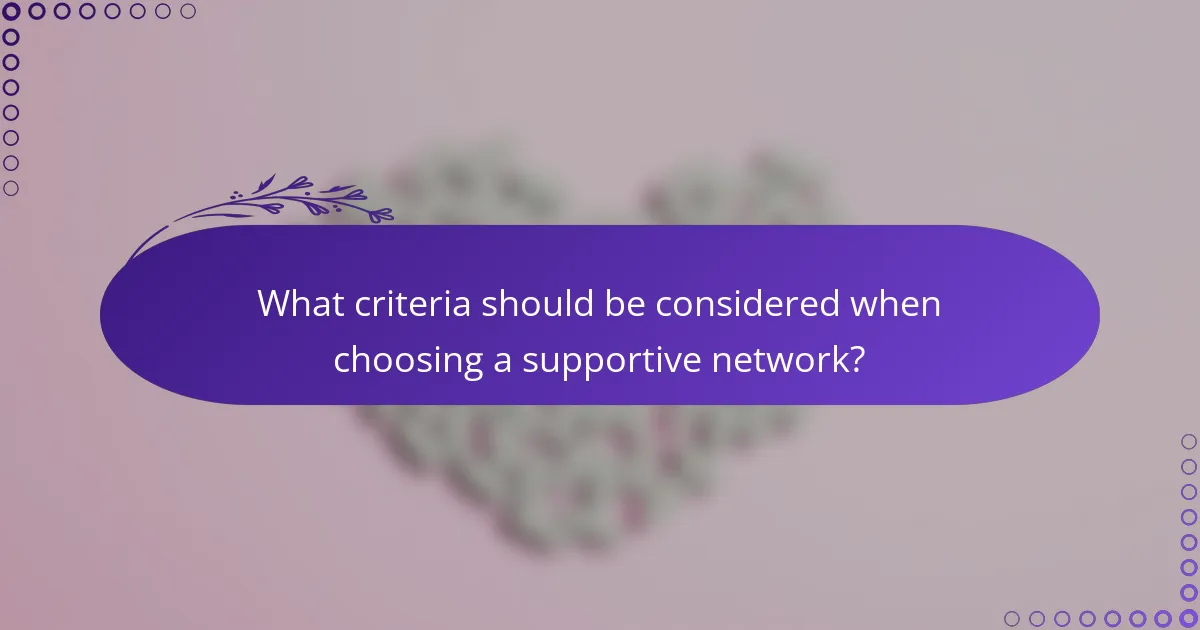
What criteria should be considered when choosing a supportive network?
When selecting a supportive network, consider factors such as shared values, accessibility, and diversity of perspectives. These criteria help ensure that the network aligns with your goals and can provide the necessary encouragement and resources.
Shared values and interests
Choosing a network with shared values and interests fosters a sense of belonging and understanding. Look for individuals or groups that resonate with your personal beliefs, lifestyle choices, or professional aspirations. This alignment can enhance motivation and commitment to mutual goals.
For example, if you are focused on health and wellness, connecting with others who prioritize fitness and nutrition can create a supportive environment. Engage in community events or online forums that reflect these shared interests to strengthen these connections.
Accessibility and location
Accessibility plays a crucial role in maintaining a supportive network. Consider how easily you can engage with your network, whether through physical proximity or virtual platforms. Local meetups or online groups can provide flexibility based on your schedule and preferences.
For instance, if you live in a city with various community centers, look for groups that meet regularly nearby. Alternatively, explore online communities that allow for interaction regardless of geographical barriers, making it easier to stay connected.
Diversity of perspectives
A diverse network enriches your experience by exposing you to different viewpoints and ideas. When selecting your supportive network, aim for a mix of backgrounds, experiences, and expertise. This diversity can lead to innovative solutions and broaden your understanding of various issues.
For example, if you are pursuing a career change, connecting with professionals from different industries can provide valuable insights and advice. Seek out networking events or workshops that encourage participation from a wide range of individuals to enhance your learning opportunities.
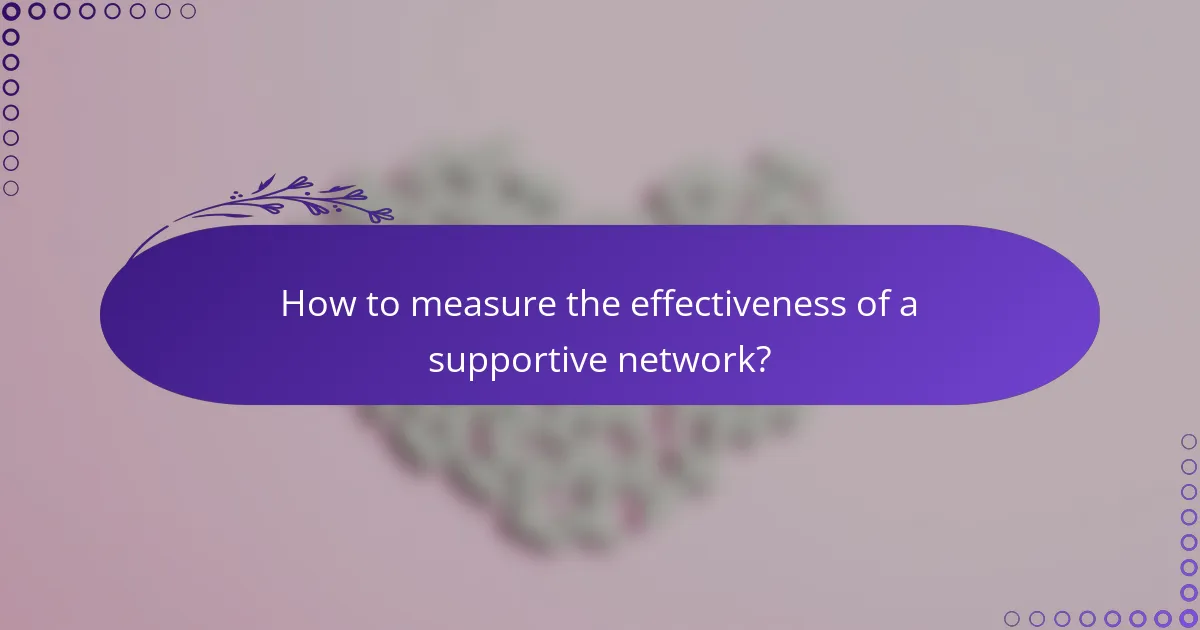
How to measure the effectiveness of a supportive network?
Measuring the effectiveness of a supportive network involves evaluating feedback, tracking personal growth, and assessing engagement levels. These factors provide insight into how well the network meets individual needs and fosters positive changes.
Feedback from members
Gathering feedback from members is crucial for understanding the network’s impact. Regular surveys or informal check-ins can help identify strengths and areas for improvement. Aim for open-ended questions to capture detailed insights about members’ experiences.
Consider using a simple rating scale for specific aspects, such as supportiveness or communication effectiveness. This quantitative data can complement qualitative feedback, offering a comprehensive view of the network’s performance.
Tracking personal growth
Tracking personal growth within a supportive network can be done through goal-setting and progress monitoring. Encourage members to set specific, measurable goals and regularly review their achievements. This practice not only highlights individual progress but also reinforces the network’s role in facilitating that growth.
Utilizing tools like journals or apps can help members document their journeys. Regularly scheduled check-ins can serve as milestones to celebrate successes and recalibrate goals as needed.
Assessing engagement levels
Assessing engagement levels within the network is essential for determining its vitality. Monitor participation in meetings, events, and discussions to gauge how actively members are involved. High engagement often correlates with a supportive atmosphere and effective networking.
Consider tracking attendance rates and participation frequency over time. If engagement dips, it may indicate a need for revitalization strategies, such as introducing new activities or enhancing communication methods to re-engage members.
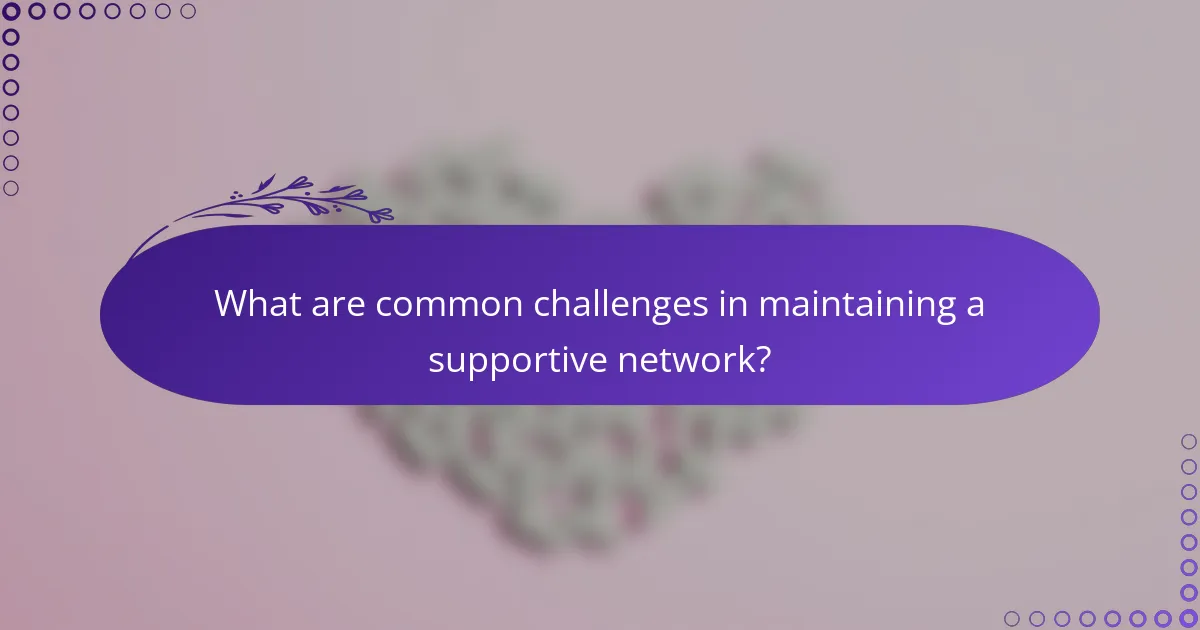
What are common challenges in maintaining a supportive network?
Maintaining a supportive network can be challenging due to factors like time constraints, geographical distance, and differing priorities among members. These challenges can lead to weakened connections and reduced support over time.
Time Constraints
Many individuals struggle to find time to nurture their supportive networks due to busy schedules. Balancing work, family, and personal commitments often leaves little room for social interactions. Prioritizing regular check-ins, even if brief, can help maintain these important relationships.
Consider setting aside specific times each week for networking activities, such as phone calls or group chats. Even short, consistent interactions can reinforce bonds and provide mutual support.
Geographical Distance
Geographical distance can hinder the ability to connect with supportive network members. When friends or family live far away, in-person meetings become less feasible, which can lead to feelings of isolation.
Utilizing technology, such as video calls and social media, can bridge this gap. Regular virtual meetups can help maintain relationships and provide emotional support, regardless of physical location.
Differing Priorities
As life circumstances change, individuals within a supportive network may develop differing priorities, which can strain relationships. For instance, one member may focus on career advancement while another prioritizes family life.
Open communication is key to navigating these differences. Discussing individual goals and finding common ground can help sustain the network and ensure that all members feel valued and supported.
